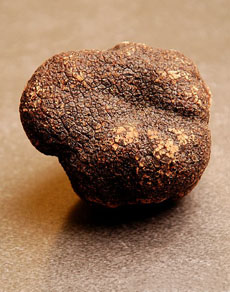
 What to do if you won’t be immediately consuming your truffle. Photos courtesy FXCuisine.com.
What to do if you won’t be immediately consuming your truffle. Photos courtesy FXCuisine.com.
|
|
|
KAREN HOCHMAN is Editorial Director of THE NIBBLE.
|
|
December 2006
Last Updated November 2013
|
 |
How To Store Fresh Truffles
Page 4: Storing Fresh Truffles
This is Page 4 of a 12-page article. Click on the black links below to visit other pages.
Storing & Handling Truffles
Truffles remain fresh for a very short time, which will vary according to the species, the maturity of the truffle, the presence of larvae and the method of storage. Of course, unless you saw it come out of the ground, you have no idea how old your truffle is when you get it, but here is the recommended process to keep truffles fresh for about two weeks following harvest:
- To keep truffles fresh, wrap them in a paper towel, place them in an airtight container and refrigerate them. This will maintain freshness for 2 to 3 days. If you’re not going to use them, clean them using the steps in the next bullet, wrap them tightly in foil, place them in an airtight plastic container and freeze them (see last bullet).
- Don’t clean truffles until you’re ready to use them. Use a mushroom brush to remove the soil, rinse with warm water and dry thoroughly with paper towels. Don’t cut them until you’re ready to use them: They lose aroma rapidly.
- If you have fresh truffles that you cannot use immediately, they can be frozen for up to six months. Vacuum-bag them, if you can, or use an airtight container to conserve the aroma. Wrap the truffles in plastic wrap, then in foil, then place into the closed container and freeze. You can also submerge them in olive oil prior to freezing, and end up with heavenly (if pricey) truffle oil, since most of the aromatic esters will transfer from the truffle to the oil.
- Take fresh, unwashed truffles and wrap them individually in paper towels.
- Place them in hermetic containers (e.g. mason jars) to seal in the aroma, very loosely packed to allow the air inside to circulate.
- Store the container on the lower shelf or door of the refrigerator, where it is less cold.
- Each day, replace the paper towel with a fresh towel and dry the condensation from the container.
- When truffles become soft, they must be consumed immediately.
- Truffles can be frozen as well; commercial ventures do this, but care must be taken to avoid the collection of moisture on the truffle due to condensation.
Black truffles release more aroma when cooked, so are generally added to sauces and risottos, stuffed into roulades and foie gras terrines, cooked with eggs, lamb, sweetbreads, seafoods, poultry....the creativity extends even to black truffle ice cream (a specialty of THE NIBBLE’s Wine Editor, Kris Prasad). The famous truffle dish Tournedos Rossini, created for the great opera composer who frequented the top restaurants in Paris, combined beef medallions, foie gras, and black truffles with Madeira. (It’s often made with wild mushrooms to make it affordable at fine restaurants year-round. We’ve included the recipe for Tournedos Rossini below.) Paradoxically, heat destroys the flavor of white truffles: They are generally grated raw over pasta, eggs, and other dishes.
Continue To Page 5: Canned Truffles
Go To The Article Index Above
Lifestyle Direct, Inc. All rights reserved. Images are the copyright of their respective owners. 
|




